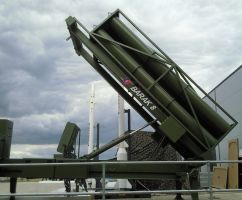Indian Navy Plans To Equip 23 Warships With Barak-8 Missile

The Indian navy plans to equip 23of its destroyers and frigates with Indo-Israel Long Range Surface to Air Missile (LRSAM), Barak-8.
The warships include aircraft carrier INS Vikramaditya during its mid-life upgradation (MLU), the two indigenous aircraft carriers being designed and built, the three Delhi-class of destroyers (built under Project 15), three Kolkata class destroyers (Project 15A), four Vishakhpatnam class destroyers (project 15B), three Shivalik class (Project 17) during MLU and seven frigates under Project 17A. India Today reported Monday.
“The Israelis announced their intention to work on Barak 8 and we too were looking at something in that range and thus the decision taken to collaborate,” a senior admiral was quoted as saying by the news channel.
While there were a number of missile systems available, only a few could take on a plane, a missile or a sea-skimming missile flying metres above the sea surface – this was the one. “The LRSAM has displayed its ability to negate ‘nodding’ – a phenomenon which takes place when a tracking radar is unable to lock on to the target flying at a significant pace close to the surface – which makes it such a good system,” he added.
Contract was signed between India’s Defence Research and Development Laboratory and Israel’s Israel Aerospace Industries (IAI). To the Indian side came the responsibility of developing the rear section of the missile whereas the lion’s share, which included the front as well as the Multi-Function Surveillance and Threat Alert Radar (MF-STAR) went to the latter. It was to be delivered for the INS Kolkata by 2010. However, neither was the ship ready by then nor was the missile.
“Two causes, apart from external factors, made us take time. First the DRDL had difficulty in developing the rocket motor and the Israelis found the same in coming up with servo control systems,” explained a source.
Following the successful test in Israel on November 10 2014, a plan was chalked out. Under this, first came the Harbour Acceptance Trial (HAT) where the INS Kolkata integrated with its systems all the components of the system including MF-STAR, sensor but not the missile. This phase lasted from August 16-27 this year. When this was smoothened, next came Sea Acceptance Trials (SAT) which took place between October and November. “Everything short of firing the actual missile happened. We even flew the MiG29K as an intruder aircraft to see if the LRSAM could track and take it on and it did. Then came the white run, just a few days ago,” said a source. This was when even a missile was fired along with the MiG29K flown in.
On December 28, about half a dozen LRSAMs were taken on board, most operational, few inert. These were the missiles which gave the navy its most advanced cover till date.While some more tests will be performed in the coming days, six months from now, the INS Kolkata, INS Kochi will get its set of missiles making these modern ships complete in their capabilities to take on aerial threats.
As of now, the navy uses the Barak 1 as its primary shield. It grants ranges of up to 9km.











